Lenovo ThinkPad X1 Yoga (2018) Review
- Paul Thurrott
- Jul 30, 2018
-
12

The 2018 Lenovo ThinkPad X1 Yoga takes everything that’s great about the X1 Carbon and puts it in a more versatile form factor. It’s a nearly ideal portable PC for those who want the best possible Windows 10 experience across a wide range of usage scenarios.
Design
The ThinkPad X1 Yoga follows this year’s ThinkPad playbook from a design perspective: I realize that ThinkPad designs seem stodgy to some, but it’s a timeless classic that eschews the flashy for the functional. Indeed, the 2018 version even scales down some past flashiness, with color-coded, rather than silver, hinges and a blacked-out ThinkPad logo on the keyboard deck. Both blend into the device’s all-black design better than did their predecessors.
Windows Intelligence In Your Inbox
Sign up for our new free newsletter to get three time-saving tips each Friday — and get free copies of Paul Thurrott's Windows 11 and Windows 10 Field Guides (normally $9.99) as a special welcome gift!
"*" indicates required fields

As a transforming—or, convertible—4-in-1 laptop, the X1 Yoga can be twisted into form factors that even more versatile than a traditional clamshell laptop. You can lay the display flat, as is possible with other ThinkPads. But you can also keep rotating the display backward and use the PC in tent, presentation, and tablet usage modes. It’s like getting 4 PCs in 1.

That capability is versatile and useful, and very much in keeping with my theories about designing for the every day and not for the occasional. That is, the ThinkPad X1 Yoga is an excellent laptop, and that is how most people will use it most of the time. But when you need to do other things, including drawing or taking notes with a smartpen, the X1 Yoga can accommodate that as well.
As with previous X1 Yogas, this year’s model also features a “rise and fall” Wave keyboard that retracts into the deck as you rotate the display back. This is kind of fun to play with and see, but it’s also practical: This retraction ensures that the keys won’t catch on the table or other surface when you use the X1 Yoga in presentation mode, where the keyboard is facing down.
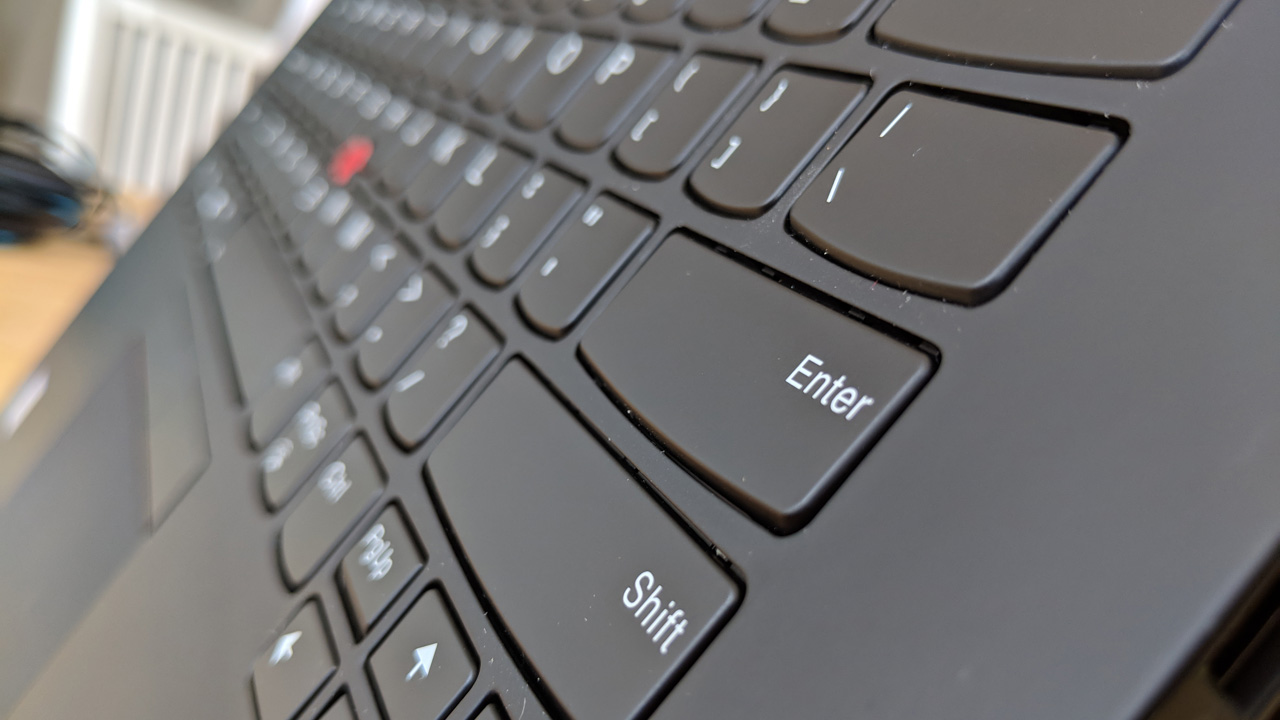
I like that. But the keyboard retraction isn’t particularly smooth: Nothing happens until the display is laid flat, and as you move past that position, there is a bit of a locking effect—more feeling than sound, really—as some threshold is reached and the keys finally do retract. If you’re not used to this, it feels wrong, but you get used to it.
Display
The ThinkPad X1 Yoga can be had with three different displays, but the review unit, sadly, came with the least interesting of the lot, a 14-inch Full HD (1920 x 1080) IPS multi-touch and smart pen-capable unit. It has decent anti-reflective capabilities, but I find it to be a bit dull, at just 300 nits.
The biggest problem with the display isn’t the resolution or brightness, however. It’s the aspect ratio: 16:9 is bad enough on a laptop where the primary focus is on productivity, and not entertainment. But it’s unacceptable on a PC that will be used as a tablet: In portrait mode, 16:9 displays look too-tall and are ungainly. A 3:2 display is a requirement for this form factor, period.
Lenovo also offers two WQHD (2560 x 1440) IPS panels, one of which is brighter (500 nits) and provides Dolby Vision HDR capabilities. There’s no OLED option this year, as there was in 2017, but I assume the Dolby Vision upgrade—it’s $310 more than base display—is meant to replace that. That panel was likewise a WQHD unit, but I’m curious if the move to Dolby Vision will result in true 4K displays down the road.
Components and ports
The 2018 ThinkPad X1 Yoga is as modern as can be from a component perspective. There are four processor choices, all of which are quad-core 8th-generation Intel Core parts, ranging from a Core i5-8250U all the way up to a Core i7-8650U. Graphics are handled by Intel’s integrated UHD Graphics 620 chipset across the board; there’s no discrete graphics option.
RAM is 8 GB on the base model, but you can upgrade to 16 GB if you choose one of three higher-end processors. And the storage is impressive: You can choose from 256 GB, 512 GB, and 1 TB SSD drives, all of which are speedy PCIe-NVMe OPAL2.0 M.2 parts.
As is the case with the display, the review unit’s specs are mostly modest (at least within the possibilities here): It utilizes the base Core i5-8250U processor, 8 GB of RAM, and 512 GB of SSD storage. In other words, it’s the base unit with a storage bump.
That said, performance has been excellent, and I’m surprised to report that I’ve never run into any issues, even with my egregious use of multiple Google Chrome tabs.
The X1 Yoga also performed well in my video encoding test, in which I convert the 4K video Tears of Steel into 1080p/30fps. It completed that test in about an hour and three minutes, just behind the Surface Book 3 (1 hour), and just ahead of the Huwaei MateBook X Pro (1:06). Last year’s dual-core X1s needed about 40 more minutes to complete the same conversion.
Noise and heat were likewise acceptable. A low fan can be heard from the right side of the PC when it’s under duress—during that video encoding test, obviously, but also when running many large applications. But I never found it to be obnoxious, and I’m very sensitive to sound.
Wireless duties are handled by Intel dual-band 8265 Wireless AC and Bluetooth 4.1. And you can also optionally add a Fibocom L850-GL 4G LTE-A (Cat-9) cellular mode for always-on connectivity.
From a connectivity perspective, the oddest thing about the X1 Yoga is that it does not include the unique docking solution found on other modern ThinkPads like the X1 Carbon and the L480—basically a set of USB-C ports, one of which sits in an adjustable-height sleeve—and I’d imagine the issue is the device’s thinness.
But Lenovo has you covered from an expansion perspective: There are two USB-C/Thunderbolt 3 ports on the left (and I believe that they are still compatible, as a set, with Lenovo’s new-generation docking solutions—as well as a single full-sized USB-A port.

On the right, you’ll find a full-sized HDMI port, a full-sized USB-A port, a mini-Ethernet port, and a standard headphone/mic jack. The power button can also be found here on the side of the keyboard deck, it’s so positioned so that you can access it no matter which form factor you’re using the X1 Yoga in.

There’s also a 4-in-1 microSD card reader, but it’s inconveniently located on the back of the PC beneath the display and behind a pull-out cover. If your X1 Yoga is provisioned with a SIM card slot, you’ll find that there too.
Windows Hello fans will have to make do with the X1 Yoga’s excellent fingerprint reader, which is my preference anyway. There’s no IR camera, but the front-mounted webcam does of course include the privacy-friendly ThinkShutter switch, which is great.

From an audio perspective, the X1 Yoga provides surprisingly rich sound with excellent stereo separation. And it’s even better with headphones, thanks to the bundled Dolby Atmos enhancements. Crank it up.
Keyboard, touchpad, and pen
The ThinkPad X1 Yoga offers excellent typing and pointing experiences, as you should expect. The “rise and fall” keyboard looks and feels like any other ThinkPad keyboard when used in the normal, raised position: The keys are scalloped, and the key throw, while a bit tall for these days, is still very good.
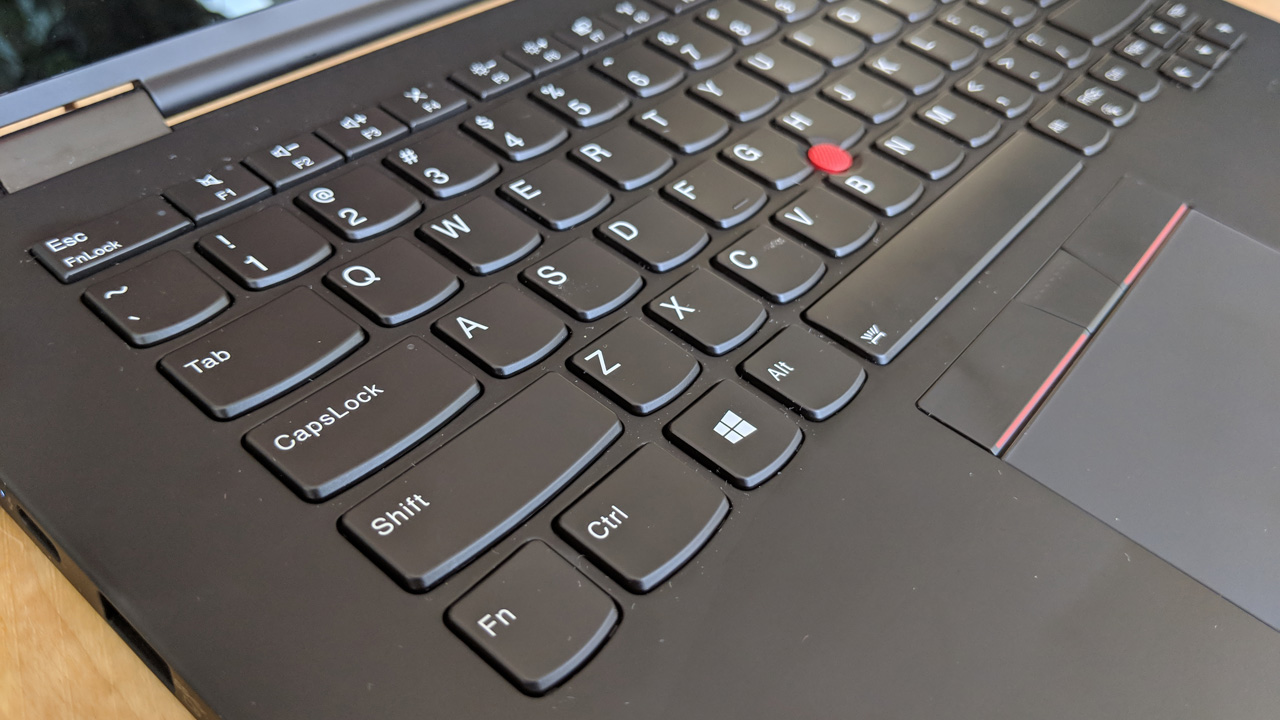
I’ve always preferred ThinkPad’s dual-pointing system, and the X1 Yoga delivers with an average-sized touchpad and my personal favorite, the TrackPoint nubbin. These are both quite accurate and work well, and the TrackPoint actually retracts into the base along with the keyboard when you fold the display over. So you won’t be losing any TrackPoint caps that way.
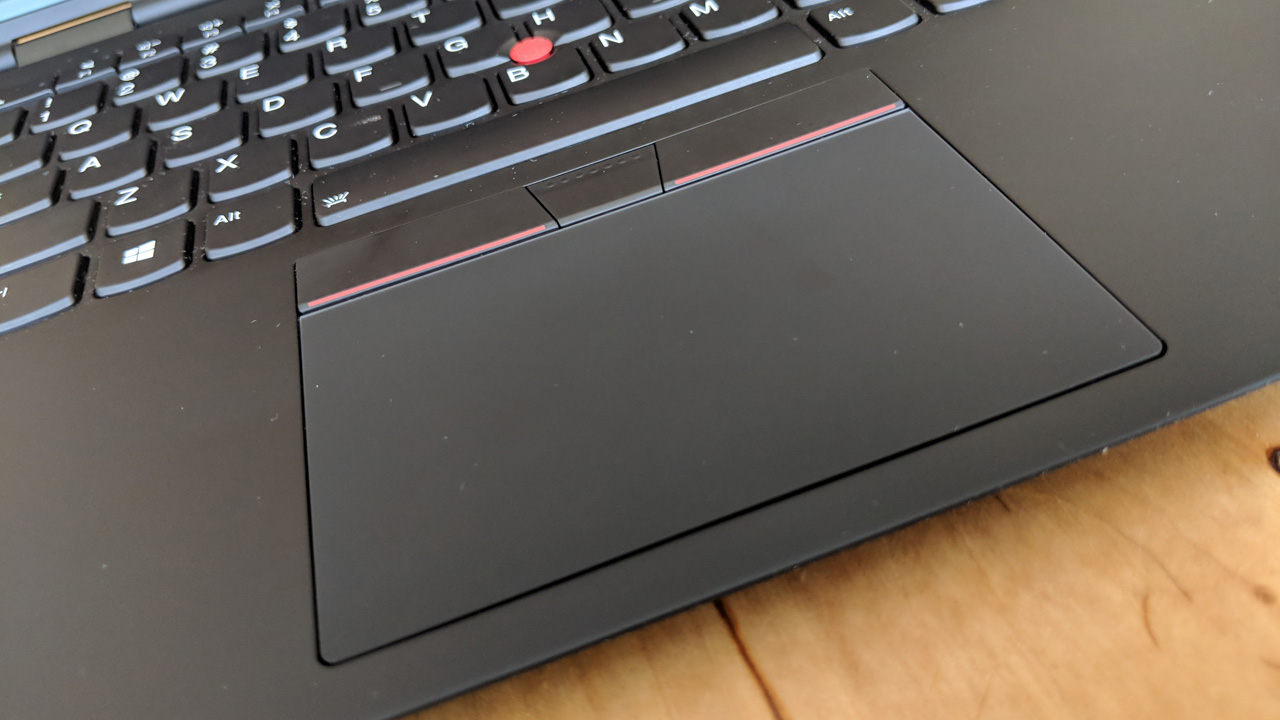
The X1 Yoga also includes a smartpen called the ThinkPad Pen Pro for creatives and note-takers. It’s a bit small for my huge hands, and it is much smaller than the Surface Pen. But it can be stowed in its own docking port—which Lenovo calls a garage—on the side of the device, which I like quite a bit.
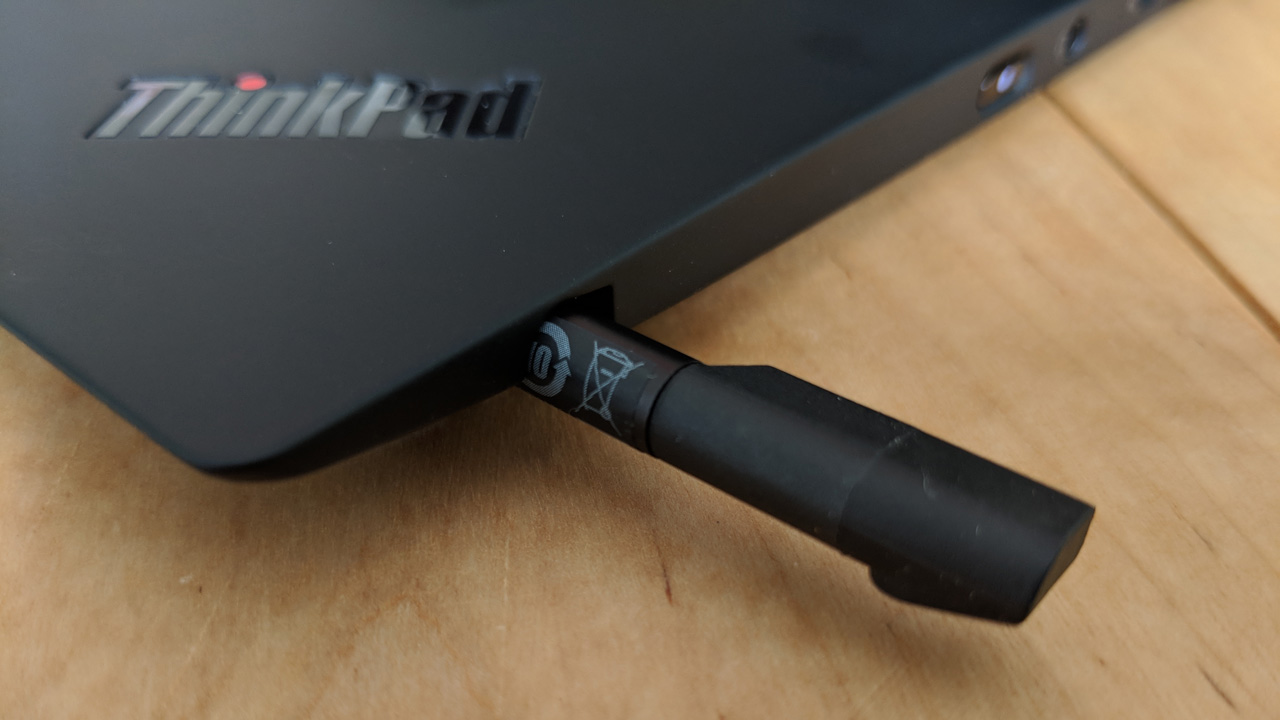
I don’t typically use a smartpen, but I did this time: I’m updating the Windows 10 Field Guide and I used the ThinkPad X1 Yoga and its ThinkPad Pen Pro to update the Windows Ink chapter last week. As you should expect just looking at it, the Pen is serviceable: it offers 2048 levels of pressure sensitivity and two buttons, but there’s no support for an eraser, tilt, or hardware acceleration. It’s a better solution for note taking than drawing, I think.
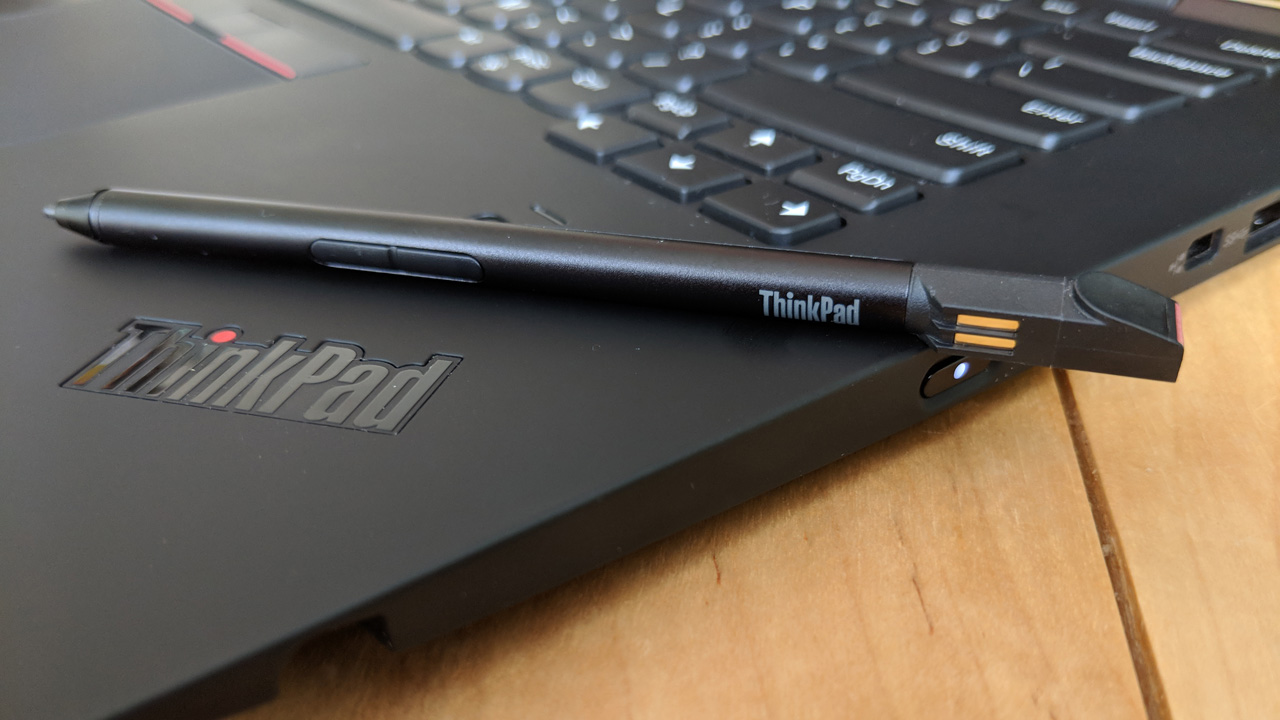
Portability
At a bit over 3 pounds, the ThinkPad X1 Yoga is roughly half a pound heavier than the X1 Carbon. It’s also a bit thicker, at .67 inches, vs. .63 inches. This is understandable, however, given the Yoga’s more versatile changeling capabilities. And I’ve found that it’s a wonderful traveling PC. I brought it with me on my three-week home swap in Sweden, as well as to Berlin as part of a side-trip, and the weight and size are excellent.
On a related note, I was unable to perform my normal battery life test—streaming HD video over Wi-Fi—because of my travels this month: The Wi-Fi connection at the home swap house is fine for day-to-day work, but it doesn’t match the speed of my home connection. And the resulting video playback was likely of lower quality than what I normally see at home. It was also jittery and glitchy.
In lieu of that—I’ll perform the formal test when we return home in mid-August—I can at least report on the X1 Yoga’s real-world battery life, which of course involves my normal mix of productivity work. And at various times, I saw between 6 and 9 and a half hours of battery life on runs where the battery was discharged to 12 percent or less of capacity. The best run clocked in at 9:27. I consider that time to be just shy of excellent.
What I can verify is that the X1 Yoga’s RapidCharge technology lets you charge the PC to 80 percent of capacity in just an hour. Depending on your needs, this capability can put a PC over the top at buying decision time.
Software
Lenovo adopted Microsoft’s Signature program for its ThinkPad products a few years ago and the resulting software image is delightfully clean. (Assuming, of course, that we ignore the crapware and advertisements that load down Windows 10.)
As with other modern ThinkPads, the X1 Yoga includes a single main Lenovo utility, called Vantage, for getting firmware and driver updates, troubleshooting and inspecting the health of the system, and the like. But there’s also a bit of bundle-creep in there too, with Mouse Properties and Wacom (smart pen) utilities notable in the Start menu.
My review laptop shipped with Windows 10 Home version 1803. You can pay for an upgrade to Windows 10 Pro, of course.
Pricing and configurations
ThinkPads aren’t cheap, and as a more versatile and tricked out sibling to the ThinkPad X1 Carbon, the X1 Yoga is predictably on the expensive side.
You can get a base Yoga for about $1670 according to the price sheet, but thanks to Lenovo’s never-ending sales, that PC will actually set you back about $1250. For that sum, you get the base Core i5 processor, 8 GB of RAM, 256 GB of speedy SSD storage, and a Full HD display.
Configured to my liking—an upgraded Core i5 processor with 16 GB of RAM and the WQHD HDR display—the ThinkPad Yoga X1 would cost about $1450. That’s actually a pretty reasonable upgrade. But you could spend upwards of $2000 if you opted for a Core i7 processor and a full 1 TB of storage.
Recommendations and conclusions
The Lenovo ThinkPad X1 Yoga is highly recommended: This is a more versatile take on the vaunted ThinkPad X1 Carbon with 4-in-1 and smart pen capabilities, excellent portability and performance, and professional and attracting-looking packaging. You may want to look elsewhere if you think you will be using the PC in tablet mode a lot or if you want first-class drawing and painting capabilities. But I find that the ThinkPad X1 Yoga delivers just the right mix of the features you’ll need every day vs. those you will use only occasionally.
At-a-glance
Pros
- Versatile design
- State of the art components
- Excellent audio
- Very good battery life, fast charging
- Clean software image (excluding the crapware in Windows 10)
Cons
- Review unit features a low-resolution display
- 16:9 is not ideal for productivity work or tablet usage
- Windows 10 includes crapware
- A bit expensive, but you get what you pay for